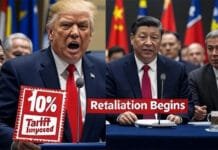INVC NEWS
ADIZ – Tensions between China and Taiwan have escalated further as Beijing continues to assert its claim over the self-ruled island. China, which considers Taiwan a breakaway province, has once again demonstrated its military might by sending 14 warships and 153 aircraft into Taiwan’s air defense identification zone (ADIZ). This bold maneuver marks a significant increase in aggressive military activities, underscoring China’s persistent efforts to intimidate Taiwan.
Rising Tensions in the Taiwan Strait
The Taiwan Strait, a body of water separating Taiwan from mainland China, has long been a hotbed of geopolitical tension. In recent years, China has intensified its military presence in the region, deploying warships, aircraft, and naval vessels in what many experts describe as part of a larger “grey zone” strategy. This latest incursion saw 111 of the 153 aircraft crossing the Taiwan Strait’s median line, a tacit boundary observed by both sides to avoid conflict.
Taiwan’s Ministry of National Defense (MND) confirmed the aggressive military activities, stating that China deployed 14 naval vessels and 12 official ships in proximity to Taiwan. The incursions began early in the morning and continued throughout the day, with Chinese aircraft entering the island’s ADIZ in multiple regions. This breach of the median line and Taiwan’s ADIZ is seen as a severe violation of Taiwan’s sovereignty, intensifying fears of a potential conflict in the region.
China’s Grey Zone Tactics: A Deliberate Show of Force
China’s incursions fall under the broader framework of its grey zone strategy, a form of military coercion that stops short of open conflict but exerts psychological and strategic pressure on the opponent. This strategy, used extensively since September 2020, aims to gradually weaken Taiwan’s defense capabilities without triggering a full-scale military response.
By continuously testing the limits of Taiwan’s defense through frequent air and naval incursions, China aims to exhaust Taiwan’s military resources, stretch its air defense systems, and erode public confidence in the island’s ability to defend itself. While these actions do not amount to direct combat, the continuous threat of military action places immense strain on Taiwan’s government and military.
The grey zone tactics also allow China to escalate its aggression incrementally, making it difficult for Taiwan or its allies to respond forcefully without risking a larger confrontation. This form of warfare is highly strategic, as it creates an atmosphere of perpetual uncertainty and instability, weakening Taiwan over time while allowing Beijing to maintain plausible deniability regarding full-scale invasion plans.
Taiwan’s Response to Chinese Aggression
Despite the severity of the incursions, Taiwan has responded with measured caution. The MND has deployed its own aircraft, naval ships, and air defense missile systems to closely monitor Chinese movements. Taiwan’s military has emphasized that it remains vigilant, prepared to counter any further provocations from the Chinese side.
Taiwan’s Defense Ministry took to social media platform X (formerly known as Twitter) to inform the public about the incursions, stating that its forces were “closely monitoring the situation” and had deployed necessary defense measures to safeguard national security. The ministry also reiterated Taiwan’s commitment to defending its sovereignty and maintaining stability in the region despite China’s provocations.
While Taiwan has not engaged in direct combat with the intruding forces, its actions signal to Beijing that any further escalations will not go unanswered. By maintaining a defensive posture and engaging in diplomatic outreach, Taiwan seeks to counter China’s aggression while avoiding an open conflict that could destabilize the entire region.
The Strategic Importance of the Taiwan Strait
The Taiwan Strait holds immense strategic significance for both Taiwan and China. For China, controlling the strait is seen as a necessary step toward achieving its long-term goal of reunification with Taiwan. The strait also serves as a critical maritime route for global trade, with large volumes of goods passing through these waters every day.
For Taiwan, the strait is not only a natural buffer but also a vital element of its national security. Taiwan’s control of the strait allows it to monitor and defend against potential incursions by Chinese forces. Given the proximity of the strait to the Chinese mainland, any loss of control over this crucial body of water would significantly undermine Taiwan’s ability to defend itself from future threats.
The strait also plays a vital role in international relations, particularly with the United States and other allies of Taiwan, such as Japan and Australia. These countries rely on Taiwan to act as a check against Chinese expansionism, particularly in the broader context of the Indo-Pacific region. A destabilization of the Taiwan Strait could lead to a larger regional conflict, drawing in global powers and potentially leading to a major geopolitical crisis.
The Role of International Allies in the Taiwan-China Conflict
As tensions between China and Taiwan continue to mount, the role of international allies, particularly the United States, has become increasingly important. The U.S. maintains a policy of “strategic ambiguity” when it comes to Taiwan, meaning it does not explicitly commit to defending Taiwan in the event of a Chinese invasion, but it also does not rule out military support.
In recent years, the U.S. has strengthened its military and diplomatic ties with Taiwan, providing it with arms sales, training, and intelligence support. Other countries in the region, such as Japan and South Korea, have also voiced concerns about China’s aggression, calling for regional cooperation to deter Beijing from further escalations.
Despite this support, Taiwan faces significant challenges in countering China’s growing military capabilities. With China’s People’s Liberation Army (PLA) boasting one of the largest and most advanced military forces in the world, Taiwan’s ability to defend itself is becoming increasingly precarious. The continuous military incursions into Taiwan’s airspace and waters are a stark reminder of the ever-present threat that China poses.
The Global Implications of China’s Military Incursions
The escalating tensions in the Taiwan Strait have far-reaching implications beyond the immediate region. A full-scale conflict between China and Taiwan could disrupt global supply chains, particularly in the technology sector, where Taiwan plays a critical role as a leading manufacturer of semiconductors. A military conflict could also draw in global powers, including the United States and its NATO allies, leading to a much larger geopolitical crisis.
The growing militarization of the Taiwan Strait is a bellwether for future conflicts in the region. As China continues to expand its influence in the South China Sea, other countries, such as the Philippines, Vietnam, and Malaysia, are closely watching how Taiwan navigates its ongoing struggle with Beijing. The outcome of this conflict could shape the future of Asian geopolitics for decades to come.
















